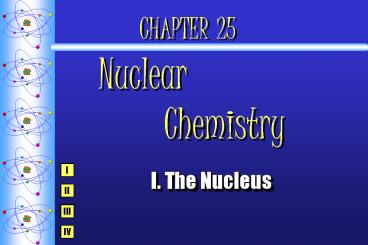CHAPTER 25 Nuclear Chemistry - PowerPoint PPT Presentation
1 / 33
Title: CHAPTER 25 Nuclear Chemistry
1
CHAPTER 25 Nuclear Chemistry
I
- I. The Nucleus
II
III
IV
2
A. Mass Defect
- Difference between the mass of an atom and the
mass of its individual particles.
4.00260 amu
4.03298 amu
3
B. Nuclear Binding Energy
- Energy released when a nucleus is formed from
nucleons. - High binding energy stable nucleus.
E mc2
E energy (J) m mass defect (kg) c speed of
light (3.00108 m/s)
4
B. Nuclear Binding Energy
Unstable nuclides are radioactive and undergo
radioactive decay.
5
CHAPTER 25 Nuclear Chemistry
I
- II. Radioactive Decay
II
III
IV
6
A. Types of Radiation
- Alpha particle (?)
- helium nucleus
paper
2
- Beta particle (?-)
- electron
1-
lead
- Positron (?)
- positron
1
concrete
- Gamma (?)
- high-energy photon
0
7
B. Nuclear Decay
- Alpha Emission
Numbers must balance!!
8
B. Nuclear Decay
- Beta Emission
- Positron Emission
9
Quick Note
- B-particles are dealing with the conversion of
neutrons ? protons and electrons - Emitted when there are too many NUETRONS
- (N gt P)
- Nuetron ? proton and electron
- Electron leaves nucleus
- Results in higher number of protons
- Positrons are particles that have the same mass
as an electron, but a positive charge, that are
emitted (released from the nucleus) to reduce
numbers of protons - Emitted when there are too many PROTONS
- (N lt P)
- Results in fewer protons
10
B. Nuclear Decay
- Electron Capture
11
Quick Note
- Electron Capture is when a nucleus absorbs one of
its own orbiting electrons to combine with a
proton in the nucleus to form a neutron - Electron proton ? neutron
- Happens when there are too many PROTONS (N lt P)
- The effect is similar to positron emission
12
B. Nuclear Decay
- Gamma Emission
- Usually follows other types of decay.
- Transmutation
- One element becomes another.
13
B. Nuclear Decay
- Why nuclides decay
- need stable ratio of neutrons to protons
DECAY SERIES TRANSPARENCY
14
B. Nuclear Decay
- Stability depends on N in comparison to P
15
C. Half-life
- Half-life (t½)
- Time required for half the atoms of a radioactive
nuclide to decay. - Shorter half-life less stable.
16
C. Half-life
- Half-life of K 1.3 billion years (VERY STABLE)
17
C. Half-life
mf final mass mi initial mass n of half-lives
18
C. Half-life
- Fluorine-21 has a half-life of 5.0 seconds. If
you start with 25 g of fluorine-21, how many
grams would remain after 60.0 s?
GIVEN t½ 5.0 s mi 25 g mf ? total time
60.0 s n 60.0s 5.0s 12
WORK mf mi (½)n mf (25 g)(0.5)12 mf 0.0061
g
19
CHAPTER 25 Nuclear Chemistry
I
- III. Fission Fusion
II
III
IV
20
A. F ission
- splitting a nucleus into two or more smaller
nuclei - 1 g of 235U 3 tons of coal
21
A. F ission
- chain reaction - self-propagating reaction
- critical mass - mass required to sustain a
chain reaction
22
B. Fusion
- combining of two nuclei to form one nucleus of
larger mass - thermonuclear reaction requires temp of
40,000,000 K to sustain - 1 g of fusion fuel 20 tons of coal
- occurs naturally in stars
23
C. Fission vs. Fusion
FISSION
FUSION
- 235U is limited
- danger of meltdown
- toxic waste
- thermal pollution
- fuel is abundant
- no danger of meltdown
- no toxic waste
- not yet sustainable
24
CHAPTER 25 Nuclear Chemistry
I
- IV. Applications
II
III
IV
25
A. Nuclear Power
- Fission Reactors
26
A. Nuclear Power
- Fission Reactors
27
A. Nuclear Power
- Fusion Reactors (not yet sustainable)
28
A. Nuclear Power
- Fusion Reactors (not yet sustainable)
National Spherical Torus Experiment
Tokamak Fusion Test Reactor Princeton University
29
B. Synthetic Elements
- Transuranium Elements
- elements with atomic s above 92
- synthetically produced in nuclear reactors and
accelerators - most decay very rapidly
30
C. Radioactive Dating
- half-life measurements of radioactive elements
are used to determine the age of an object - decay rate indicates amount of radioactive
material - EX 14C - up to 40,000 years 238U and 40K - over
300,000 years
31
D. Nuclear Medicine
- Radioisotope Tracers
- absorbed by specific organs and used to diagnose
diseases - Radiation Treatment
- larger doses are used to kill cancerous cells
in targeted organs - internal or external radiation source
32
E. Nuclear Weapons
- Atomic Bomb
- chemical explosion is used to form a critical
mass of 235U or 239Pu - fission develops into an uncontrolled chain
reaction - Hydrogen Bomb
- chemical explosion ? fission ? fusion
- fusion increases the fission rate
- more powerful than the atomic bomb
33
F. Others
- Food Irradiation
- ? radiation is used to kill bacteria
- Radioactive Tracers
- explore chemical pathways
- trace water flow
- study plant growth, photosynthesis
- Consumer Products
- ionizing smoke detectors - 241Am

